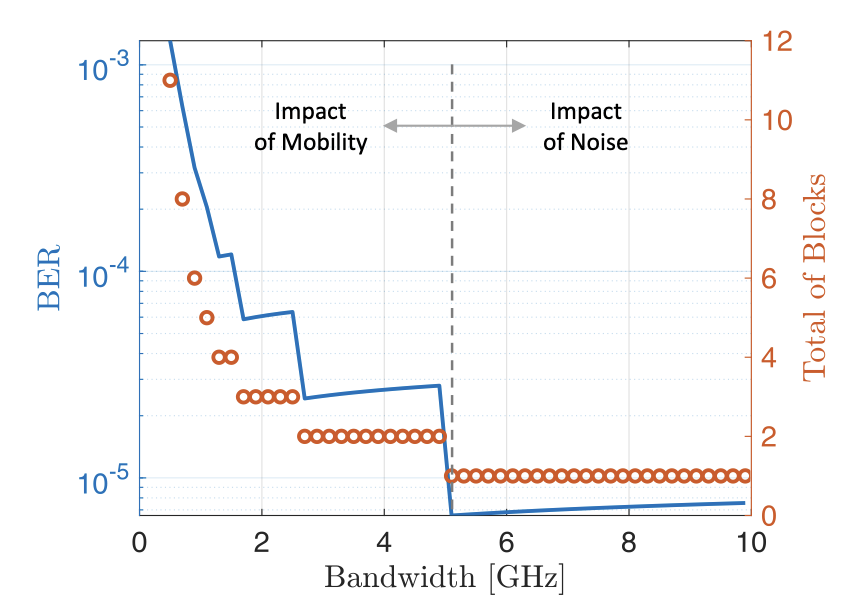Literature Database Entry
le2021dynamic
Minh Hieu Le, "Dynamic Resource Allocation for Low-Delay Video Streaming in the Uplink of OFDMA Mobile Networks," PhD Thesis, School of Electrical Engineering and Computer Science (EECS), TU Berlin (TUB), September 2021. (Advisor: Adam Wolisz; Referees: Adam Wolisz, Anja Klein and Holger Karl)
Abstract
In recent years, video has been inducing an exponential growth in mobile traffic. Today, mobile operators pay several billions of euros for radio frequency bands to cope with enormous traffic demands. At the same time, the enduring demand growth increasingly forces mobile operators and video service providers to look for efficient solutions to make the best possible service quality out of the limited radio spectrum. This thesis focuses on improving the Quality of Experience (QoE) of multiple low-delay video streams in the uplink of mobile networks using Orthogonal Frequency Division Multiple Access (OFDMA). Several mobile networks like LTE and WiMAX have been using OFDMA. In that context, this thesis provides multiple contributions. The first contribution is a novel dynamic resource allocation approach, which exploits wireless channels' random variations to improve user throughput while suppressing Multiple Access Interference (MAI). MAI presents when user signals are not perfectly synchronous in the uplink of OFDMA networks. Next, the thesis presents two cross-layer video adaptation approaches, which adopt the introduced dynamic resource allocation approach. Those two approaches target low-delay video streaming services using non-layered and layered video coding. While the video industry has been broadly using non-layered video coding, layered video coding might be more prevalent in the future. Those two technologies have distinct adaptation principles, so they require different solutions tailored particularly for them. In both cases, via efficient mathematical transformations, the large-timescale problem of video adaptation (in a few seconds) is pursued via a series of small-timescale resource allocation problems (each in a few milliseconds). By doing that, video adaptation algorithms can quickly react to wireless channel variations and meet low latency requirements. As for non-layered video coding, another contribution is to consider potential throughput gains via efficient resource allocation algorithms as selecting video quality. Throughout the thesis, we develop several mathematical optimization problems and adaptation algorithms to determine the performance gain of proposed approaches.
Quick access
Original Version ![]() (at publishers web site)
(at publishers web site)
BibTeX ![]()
Contact
Minh Hieu Le
BibTeX reference
@phdthesis{le2021dynamic,
author = {Le, Minh Hieu},
doi = {10.14279/depositonce-14979},
title = {{Dynamic Resource Allocation for Low-Delay Video Streaming in the Uplink of OFDMA Mobile Networks}},
advisor = {Wolisz, Adam},
institution = {School of Electrical Engineering and Computer Science (EECS)},
location = {Berlin, Germany},
month = {9},
referee = {Wolisz, Adam and Klein, Anja and Karl, Holger},
school = {TU Berlin (TUB)},
type = {PhD Thesis},
year = {2021},
}
Copyright notice
Links to final or draft versions of papers are presented here to ensure timely dissemination of scholarly and technical work. Copyright and all rights therein are retained by authors or by other copyright holders. All persons copying this information are expected to adhere to the terms and constraints invoked by each author's copyright. In most cases, these works may not be reposted or distributed for commercial purposes without the explicit permission of the copyright holder.
The following applies to all papers listed above that have IEEE copyrights: Personal use of this material is permitted. However, permission to reprint/republish this material for advertising or promotional purposes or for creating new collective works for resale or redistribution to servers or lists, or to reuse any copyrighted component of this work in other works must be obtained from the IEEE.
The following applies to all papers listed above that are in submission to IEEE conference/workshop proceedings or journals: This work has been submitted to the IEEE for possible publication. Copyright may be transferred without notice, after which this version may no longer be accessible.
The following applies to all papers listed above that have ACM copyrights: ACM COPYRIGHT NOTICE. Permission to make digital or hard copies of part or all of this work for personal or classroom use is granted without fee provided that copies are not made or distributed for profit or commercial advantage and that copies bear this notice and the full citation on the first page. Copyrights for components of this work owned by others than ACM must be honored. Abstracting with credit is permitted. To copy otherwise, to republish, to post on servers, or to redistribute to lists, requires prior specific permission and/or a fee. Request permissions from Publications Dept., ACM, Inc., fax +1 (212) 869-0481, or permissions@acm.org.
The following applies to all SpringerLink papers listed above that have Springer Science+Business Media copyrights: The original publication is available at www.springerlink.com.
This page was automatically generated using BibDB and bib2web.

